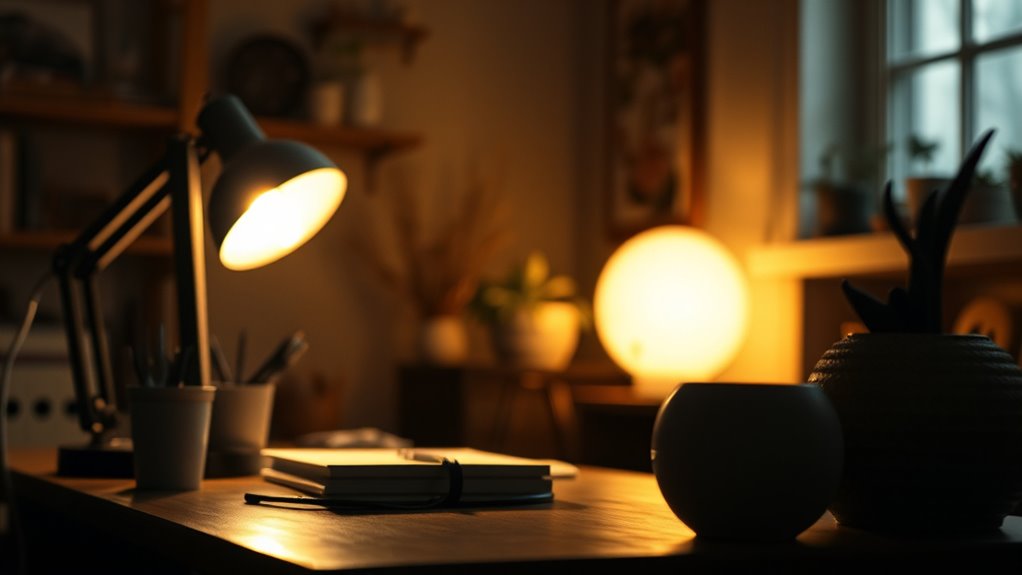To create a well-balanced space with Lighting Layers—task, ambient, and accent—you’ll need to focus on purpose and placement. Use focused task lights for safety and productivity, soft ambient lighting for warmth and mood, and accent lights to highlight architectural details or décor. Combining these layers with adjustable fixtures and smart controls helps you achieve flexibility and harmony. Keep exploring to discover how to optimize each layer for your specific environment and style.
Key Takeaways
- Task lighting provides focused illumination for activities, safety, and visual clarity.
- Ambient lighting creates a soft, warm environment that sets the overall mood of a space.
- Accent lighting highlights architectural features, artwork, or decorative objects to add visual interest.
- Combining all three layers ensures a balanced, versatile, and aesthetically pleasing lighting scheme.
- Proper fixture selection, placement, and control are essential for effective layering and mood adjustment.
Understanding the Role of Task Lighting
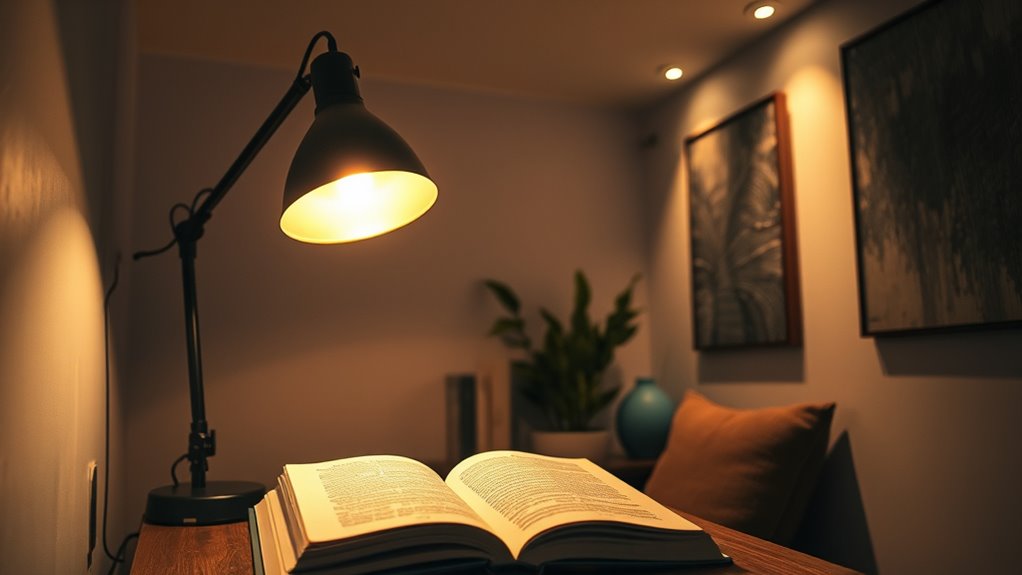
Task lighting plays a crucial role in enhancing both safety and productivity in any space. It helps you see clearly when performing specific activities, reducing eye strain and preventing accidents. Whether you’re cooking, reading, or working at a desk, proper task lighting ensures you have enough illumination right where you need it. You can achieve this with focused light sources like under-cabinet lights, desk lamps, or adjustable fixtures. By directing light accurately, you eliminate shadows and glare that can cause discomfort or mistakes. Effective task lighting makes your tasks easier and more comfortable, whether at home or in the workplace. It’s an essential layer of lighting that supports your daily activities and keeps you safe while working or engaging in detailed tasks. Additionally, selecting the right projector technology can significantly enhance visual clarity and color accuracy during presentations or entertainment.
Creating a Cozy Atmosphere With Ambient Lighting

Have you ever wondered how to make a room feel warm and inviting? Ambient lighting is your tool for creating that cozy atmosphere. Soft, diffused light fills the space without glare, making it feel comfortable and relaxing. Use warm-colored bulbs or dimmable fixtures to adjust the mood easily. Layer different sources like floor lamps, table lamps, or wall sconces for depth. Here’s a quick guide:
| Light Source | Placement | Effect |
|---|---|---|
| Floor lamps | Corners, near seating | Adds warmth and depth |
| Table lamps | Side tables, desks | Creates pools of gentle light |
| Wall sconces | Walls, hallways | Softens shadows, highlights textures |
This approach guarantees your space feels welcoming while maintaining a soothing glow. Incorporating lighting layers allows you to customize the ambiance precisely to your liking.
Highlighting Features With Accent Lighting

Once you’ve set a cozy foundation with ambient lighting, accent lighting can truly make key features stand out. It draws attention to artwork, architectural details, or decorative objects, adding visual interest. To achieve this, use focused light sources like spotlights, track lights, or wall-mounted fixtures. Proper placement is essential: position lights at an angle to minimize glare and highlight textures or colors. Consider the following: highlight artwork or sculptures, emphasize architectural features like moldings, accentuate textured walls, showcase decorative vases or collections, create focal points in a room, and remember that lighting techniques are crucial for achieving the desired effect.
Selecting the Right Fixtures for Each Layer
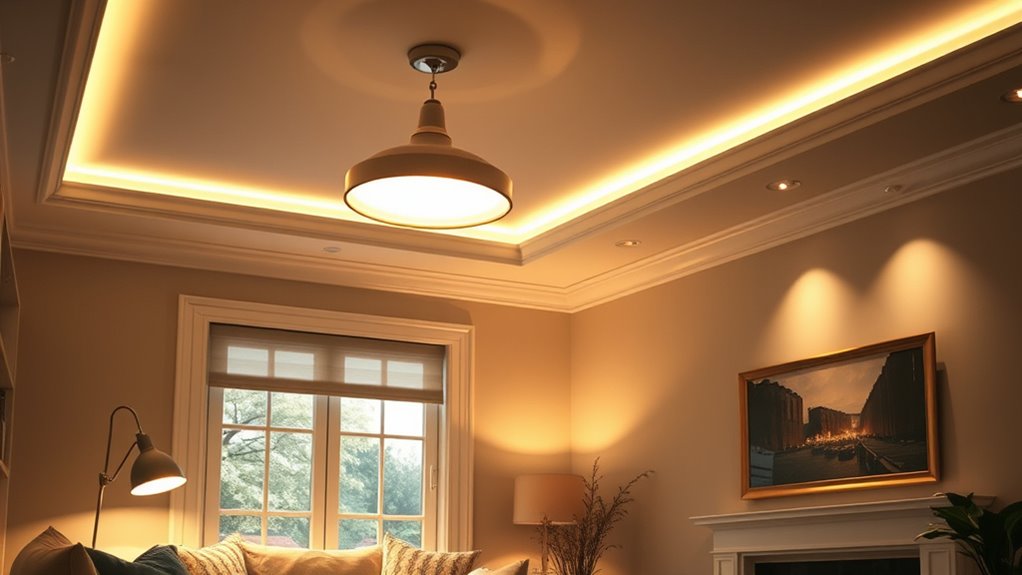
Choosing the right fixtures for each lighting layer is essential to create a balanced and functional space. For task lighting, opt for focused fixtures like adjustable pendants, under-cabinet lights, or reading lamps that direct light where needed. Ambient lighting benefits from ceiling-mounted fixtures, recessed lights, or chandeliers that provide even, overall illumination. For accent lighting, choose spotlights, track lights, or wall-mounted fixtures that highlight artwork, architectural features, or decorative objects. Consider fixture styles, bulb types, and brightness levels to match the purpose of each layer. Properly selected fixtures guarantee each layer complements the others, avoiding harsh shadows or overly bright spots. Additionally, understanding the operating hours of different venues can help plan your visits for optimal lighting and experience. Tailoring your fixtures to each layer enhances both the usability and aesthetic appeal of your space.
Balancing Light Levels for a Harmonious Space
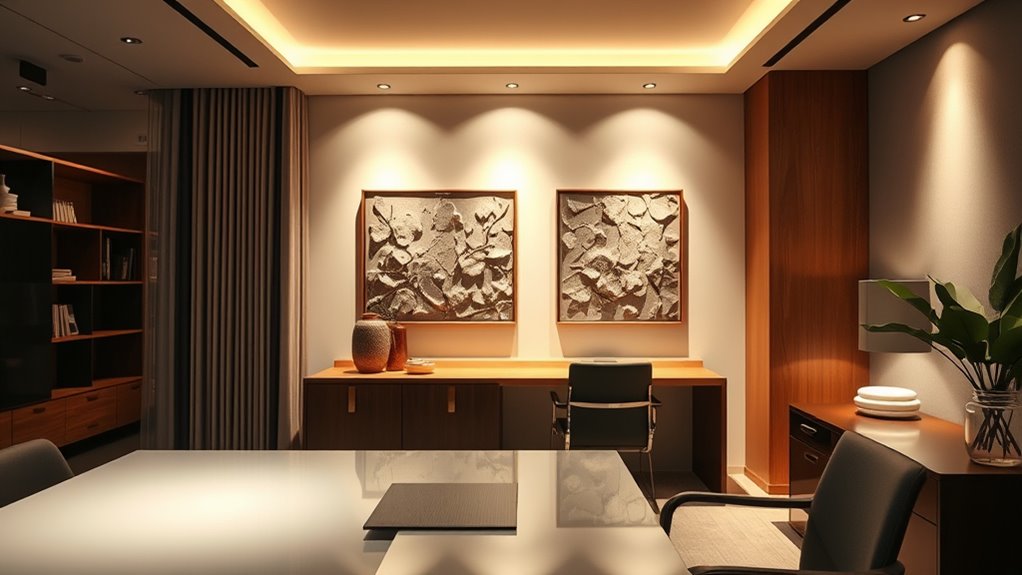
Achieving a harmonious space depends on balancing light levels across all lighting layers to prevent areas that are too bright or too dim. Proper balance guarantees comfort, functionality, and visual appeal. To do this effectively:
- Use dimmers to fine-tune brightness in different zones
- Layer multiple light sources for flexibility
- Incorporate task lighting where needed without overpowering the space
- Adjust fixtures to distribute light evenly
- Consider the natural light cycle and supplement accordingly
- Be mindful of light spectrum to ensure a comfortable and natural ambiance
Tips for Layering Lighting in Different Rooms
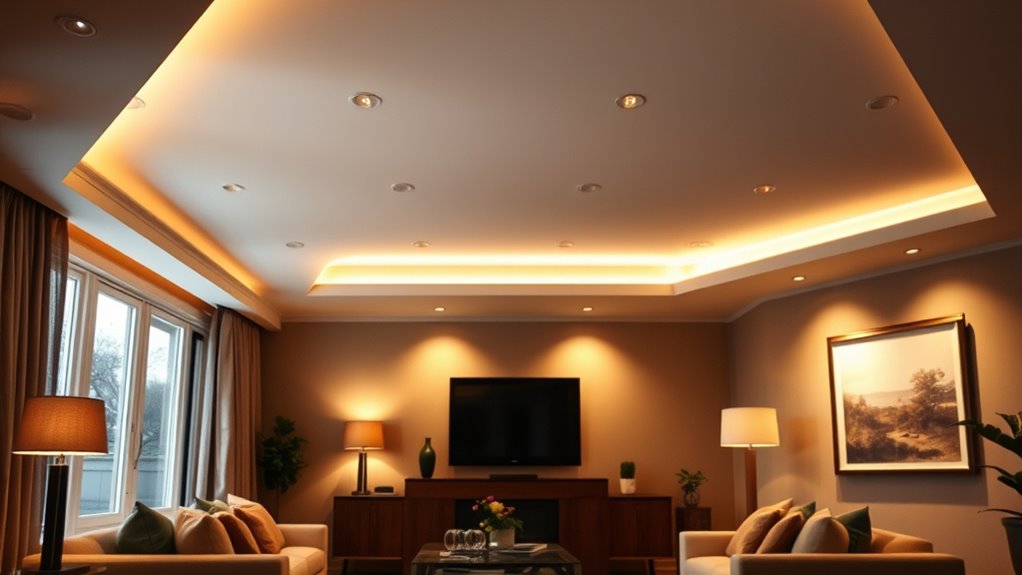
When layering lighting in different rooms, it’s important to tailor your approach to each space’s specific function and mood. For a kitchen, prioritize task lighting over work surfaces, like under-cabinet lights, and add ambient lighting for general brightness. Living rooms benefit from a mix of ambient fixtures, such as ceiling lights, combined with accent lights to highlight artwork or architectural features. In bedrooms, create a relaxing atmosphere with soft ambient lighting, complemented by task lighting near reading areas. Bathrooms require bright, even lighting for grooming, with layered fixtures around mirrors. Always consider the natural light available and adjust your layers accordingly. To ensure safety and proper function, make sure to inflate lighting fixtures properly, especially in outdoor or wet environments. By customizing your lighting layers to each room’s purpose, you’ll create a functional, inviting space that feels balanced and well-designed.
Common Mistakes to Avoid When Layering Lights
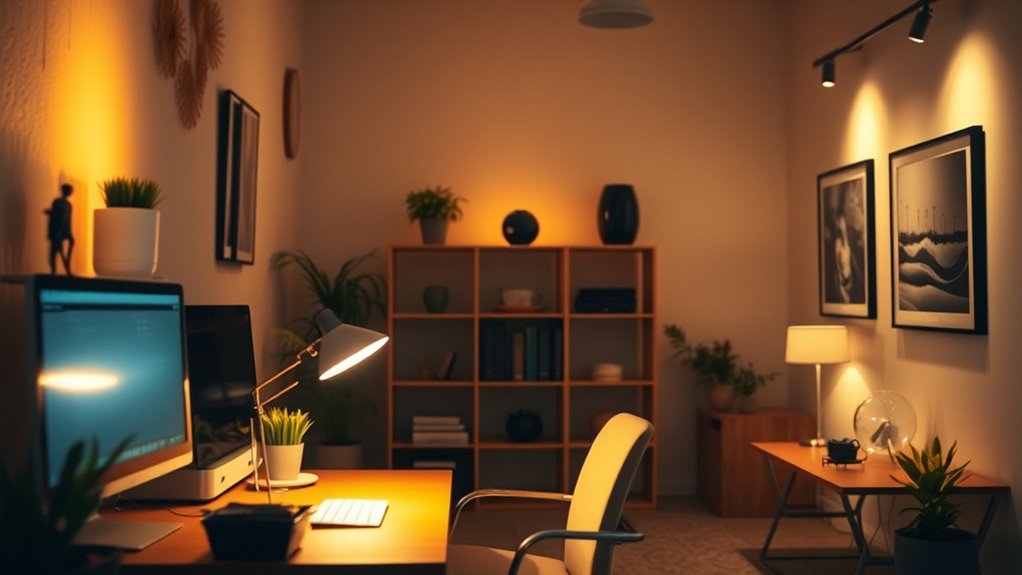
One common mistake is overlapping light sources, which can create glare or harsh shadows. Ignoring focal points might leave important areas dark or underlit, disrupting the room’s balance. Additionally, uneven light distribution can make a space feel awkward or uninviting; paying attention to these issues helps create a cohesive look. Incorporating lighting layers thoughtfully can enhance both functionality and aesthetics of the space.
Overlapping Light Sources
Overlapping light sources can create confusion and unwanted shadows if not carefully managed. Too many lights in the same area can make a space feel chaotic or overly bright, undermining the purpose of layered lighting. To avoid this, be mindful of how different lights interact and overlap. Additionally, understanding light layering principles can help you design a balanced and harmonious lighting scheme. Consider these common pitfalls:
- Using multiple fixtures with similar brightness levels in the same spot
- Positioning lights too close together, causing glare
- Overlapping different color temperatures, creating visual discord
- Ignoring the importance of light direction and shadow patterns
- Over-illuminating a space, reducing its warmth and ambiance
Ignoring Focal Points
Have you ever overlooked a room’s natural focal point when layering your lighting? It’s a common mistake that can make your space feel disjointed or uninviting. Instead of evenly distributing light everywhere, focus on highlighting key features like artwork, a fireplace, or architectural details. Failing to do so leaves these elements in shadow, reducing visual interest and depth. When planning your lighting, identify the room’s focal points first, then layer your task, ambient, and accent lights around them. This approach draws attention where you want it most and creates a cohesive, inviting atmosphere. Ignoring focal points results in flat lighting that fails to showcase your space’s best features. Always consider what draws the eye and plan your layers to enhance those elements. Recognizing visual hierarchy can help you prioritize lighting effects that emphasize your space’s unique attributes.
Uneven Light Distribution
When layering your lighting, it’s easy to focus on placing fixtures without considering how evenly they distribute light across the space. Uneven lighting can create dark spots or overly bright areas, making the room feel unbalanced. To avoid this, pay attention to fixture placement and beam angles. Keep in mind:
- Overlapping light sources for consistent coverage
- Avoiding too many fixtures in one area
- Using dimmers to adjust brightness levels
- Balancing task, ambient, and accent lights
- Considering wall color and reflectivity to enhance light diffusion
- Understanding lighting distribution helps optimize the overall illumination and achieve a harmonious look.
Innovative Techniques for Modern Lighting Designs
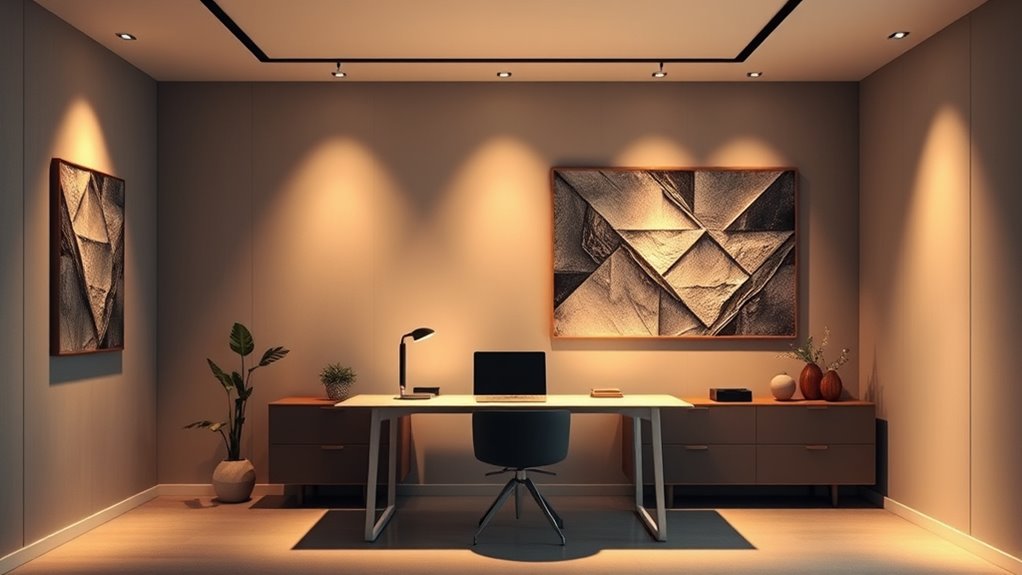
You can transform your space by integrating layered lighting seamlessly and creatively. Using dynamic light control allows you to adjust ambiance easily, making your design adaptable to any mood or activity. Exploring these innovative techniques helps you achieve a modern, functional, and visually striking environment.
Layered Light Integration
Layered light integration has become essential in modern lighting design, allowing for dynamic and versatile environments. By combining different layers—task, ambient, and accent—you create a balanced space that adapts to various activities and moods. To achieve seamless integration, consider these techniques:
- Use dimmable fixtures to adjust lighting levels easily
- Incorporate smart controls for personalized settings
- Layer multiple light sources with complementary color temperatures
- Utilize recessed, pendant, and wall-mounted fixtures for depth
- Plan for shadows and highlights to enhance architectural features
This approach ensures your space is functional, inviting, and visually engaging. Proper integration not only improves usability but also elevates aesthetic appeal, making your environment adaptable and sophisticated.
Dynamic Light Control
Have you explored the latest innovations in lighting control that transform static environments into dynamic spaces? Modern lighting design now leverages smart systems that adapt to your needs in real time. You can use dimming controls, color-changing LEDs, or automated presets to shift moods instantly. Motion sensors and timers help optimize energy use while keeping spaces flexible. With wireless apps and voice commands, you gain full control from anywhere, creating personalized scenes for work, relaxation, or entertainment. Integrating sensors and automation allows your lighting to respond to natural light changes or occupancy, enhancing comfort and efficiency. These innovative techniques make your environment more responsive, engaging, and adaptable, elevating your space beyond traditional static lighting setups.
Maintaining and Adjusting Your Lighting Layers
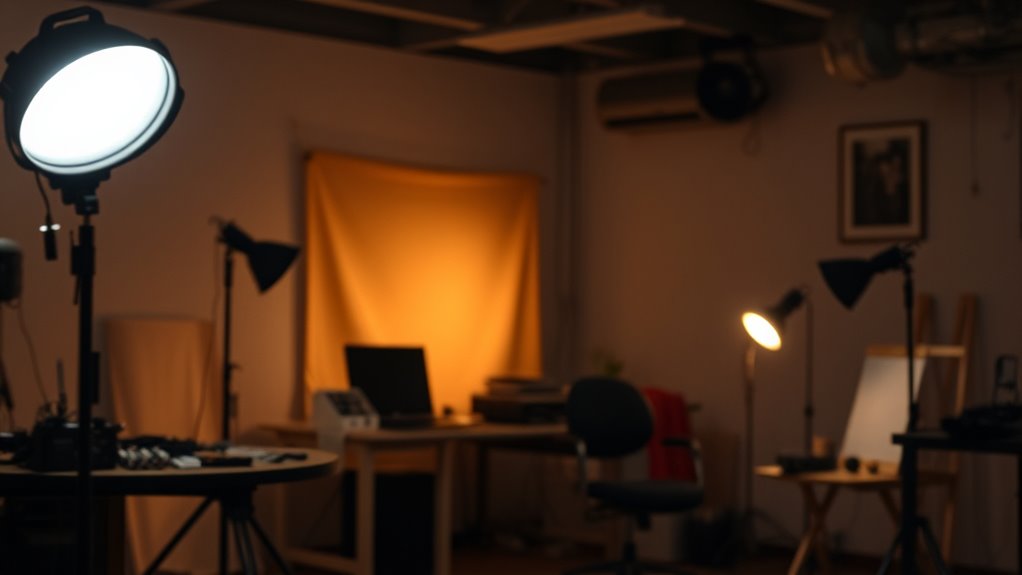
Maintaining and adjusting your lighting layers is essential for achieving the perfect balance and mood in your scene. Regular tweaks guarantee each layer complements the others, creating a cohesive atmosphere. To do this effectively, consider these key points:
- Monitor overall brightness to avoid over- or under-lighting.
- Balance shadows and highlights for depth and dimension.
- Adjust color temperatures to match the scene’s mood.
- Use dimmers and controls for precise fine-tuning.
- Evaluate from different angles and distances to ensure consistent lighting.
Frequently Asked Questions
How Do I Determine the Appropriate Brightness for Each Lighting Layer?
When figuring out the right brightness, you should consider the purpose of each space and activity happening there. For task lighting, make it bright enough to see clearly without causing glare. Ambient lighting should be softer, creating a comfortable background. Accent lighting highlights features, so it can be slightly brighter or focused. Adjust brightness levels based on comfort and functionality, and test different settings to find what feels right for each area.
Can Layering Lights Help Reduce Overall Energy Consumption?
Think of lighting layers as a symphony, where each instrument plays its part. Layering lights can indeed reduce energy use because you focus brightness only where needed, avoiding over-lighting the entire space. By using task, ambient, and accent lights strategically, you optimize energy consumption while maintaining the desired atmosphere. This approach is like a well-conducted orchestra, balancing efficiency with effective illumination.
What Are the Best Color Temperatures for Different Lighting Layers?
Choosing the right color temperature enhances your lighting’s effectiveness. For general use, aim for 2700K to 3000K to create warm, inviting environments. For task lighting, go for cooler temperatures around 3500K to 4100K to boost alertness and focus. Accent lights benefit from warmer tones, about 2700K, to highlight features without overwhelming. Adjust these based on your mood preferences and the specific space to optimize comfort and functionality.
How Do I Incorporate Smart Lighting Controls Into Layered Designs?
Imagine your lighting system as a symphony, each control a conductor guiding different sections. To incorporate smart controls, you’ll want to program scenes that adjust color temperatures and brightness for various activities. Use apps or voice commands to switch moods effortlessly, like dimming warm ambient light for cozy evenings or bright cool task lighting for work. This creates a seamless, dynamic environment tailored to your needs.
Are There Specific Styles of Fixtures Ideal for Each Lighting Layer?
You can choose fixtures that suit each lighting purpose by focusing on their function and style. For task lighting, opt for adjustable, focused fixtures like desk lamps or under-cabinet lights. For ambient lighting, choose flush mounts or recessed fixtures that provide a soft, even glow. Accent lighting benefits from directional spotlights or wall-mounted fixtures that highlight artwork or architectural features. Matching fixture styles to their roles enhances both form and function in your design.
Conclusion
So, now that you know the secret recipe—task, ambient, and accent lighting—you’re basically a lighting guru. Just remember, mixing up your layers isn’t rocket science, but ignoring them might make your space look like a blackout. Don’t be that person who’s afraid to experiment or, worse, leaves all the lights on all the time. With these tips, your home will shine brighter than your neighbor’s, and you’ll finally get that well-lit Instagram shot. Happy lighting!
